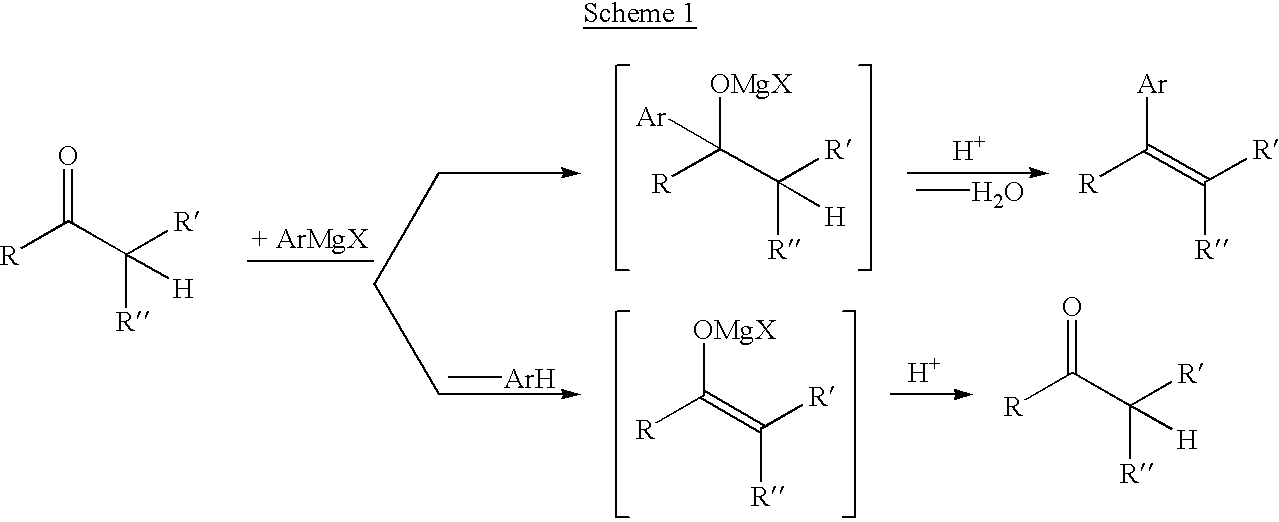Process for preparing vinylaromatic compounds
a technology of vinylaromatic compounds and vinylaromatic compounds, which is applied in the field of effective and efficient process for the preparation of vinylaromatic compounds, can solve the problems of chemical yield loss, recovery yield loss, and practically useless for the preparation of the desired vinylaromatic compound, and achieve the effect of effective and efficient process
- Summary
- Abstract
- Description
- Claims
- Application Information
AI Technical Summary
Benefits of technology
Problems solved by technology
Method used
Image
Examples
example 1
This Example illustrates the process of the invention wherein a ketone-derived vinylphosphate is reacted with an arylmagnesium reagent in the presence of palladium catalyst comprising a phosphine ligand to produce a vinylaromatic compound.
A solution of 0.330 g (1.00 mmol) 1-cyclohexen-1-yl diphenyl phosphate (reference: J. Org. Chem. vol. 52 (1987), pp. 4185-41980), 0.092 g (0.50 mmol) tridecane (internal GC standard), and 7 mg (0.01 mmol) dichlorobis(triphenylphosphine)palladium in 2 mL THF (tetrahydrofuran) was heated to 65.degree. C. and treated dropwise with 0.60 mL (1.25 mmol) 2.08 M phenylmagnesium chloride in THF. After heating at 65.degree. C. for 1 h (hour), a sample was withdrawn from the reaction and quenched in a mixture of ether and aqueous 1 M sodium citrate. Analysis of the organic phase by GC (gas chromatography) showed the presence of 0.81 mmol 1-phenyl-1-cyclohexene (81% chemical yield on 1-cyclohexen-1-yl diphenyl phosphate) and 0.02 mmol (2%) unreacted 1-cyclohex...
example 2
This Example illustrates the process of the invention wherein an aldehyde-derived vinylphosphate is reacted with an arylmagnesium reagent in the presence of palladium catalyst comprising a phosphine ligand to produce a vinylaromatic compound (in this example, a stilbene).
2-Phenylvinyl diphenyl phosphate was prepared by treating a solution of 4.6 mL (22 mmol) diphenyl chlorophosphate and 3.6 mL (24 mmol) 1,8-diazabicyclo[5.4.0]undec-7-ene in 20 mL methylene chloride 0.degree. C. with 2.6 mL (20 mmol) phenylacetaldehyde (90% purity. The solution was stirred at 0.degree. C. for 6 h, poured into a mixture of water and ether (75 mL each), and the organic phase was extracted twice with 0.1 N HCl (50 mL each) and then washed with brine (25 mL). The organic phase was then dried over MgSO.sub.4, filtered, and concentrated. Distillation using a Kugelrohr apparatus (225.degree. C. / 0.1 torr) provided 6.4 g 2-phenylvinyl diphenyl phosphate (90% yield) as an approximately equal mixture of E and Z...
examples 3-8
These Example illustrate the process of the invention wherein an enolizable ketone is reacted with a sterically hindered Grignard reagent and a halophosphate diester to produce a vinylphosphate.
A solution of 2.0 mmol tetralone (0.27 mL 1-tetralone; 0.26 mL 2-tetralone) and 0.46 mL (2.2 mmol) of diphenyl chlorophosphate in 2 mL THF was cooled to 0.degree. C. and treated with 2.04 mmol of Grignard reagent in THF (1.89 mL 1.08 M mesitylmagnesium bromide; 1.02 mL 2.00 M isopropylmagnesium chloride; 2.04 mL 1.00 M t-butylmagneisum chloride). The solution stirred at 0.degree. for 15 min, and allowed to warm to room temperature with stirring for an additional 30 min. Tridecane (0.24 mL; 1.0 mmol; internal GC standard) was added and a sample withdrawn and hydrolyzed in a mixture of ether and aqueous 1 M sodium citrate. GC analysis of the organic phase showed the conversion of the tetralone and the chemical yield of the vinyl phosphate product (3,4-dihydronaphthalene-1-yl diphenyl phosphate ...
PUM
| Property | Measurement | Unit |
|---|---|---|
| Fraction | aaaaa | aaaaa |
| Fraction | aaaaa | aaaaa |
| Fraction | aaaaa | aaaaa |
Abstract
Description
Claims
Application Information
 Login to View More
Login to View More - R&D
- Intellectual Property
- Life Sciences
- Materials
- Tech Scout
- Unparalleled Data Quality
- Higher Quality Content
- 60% Fewer Hallucinations
Browse by: Latest US Patents, China's latest patents, Technical Efficacy Thesaurus, Application Domain, Technology Topic, Popular Technical Reports.
© 2025 PatSnap. All rights reserved.Legal|Privacy policy|Modern Slavery Act Transparency Statement|Sitemap|About US| Contact US: help@patsnap.com



